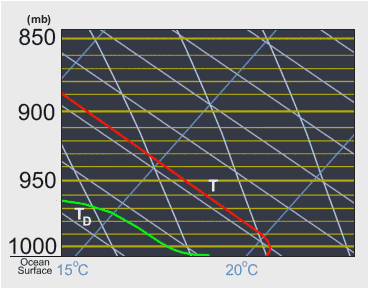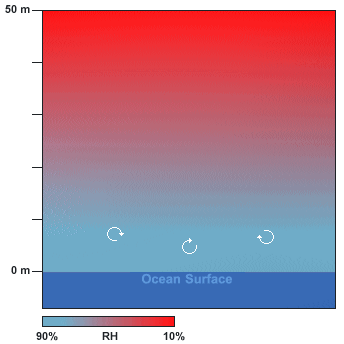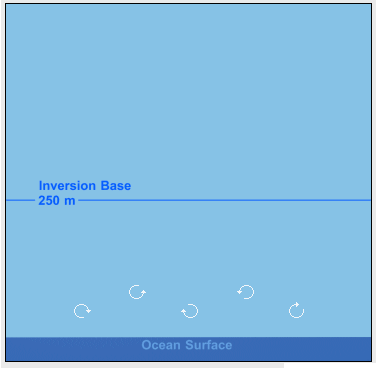In Depth
Moistening of the Marine Boundary Layer

When warm air passes over a cool sea surface, a well-mixed, cool, moist, marine boundary layer develops. Here we examine the physical processes that moisten the boundary layer under these conditions.
Moistening of the marine boundary layer begins at the base of a relatively dry air mass as it moves over the ocean. Moistening occurs initially at the surface and slowly mixes upward via mechanical turbulence. The moistened layer deepens gradually. This moistening is indicated by rising dewpoints, as depicted in this schematic skew-T animation
What is Vapor-driven Convection?

How does the moist surface layer mix vertically? The moistened air parcels in the low levels slowly become convectively buoyant. This buoyancy creates small-scale "vapor-driven" convection that enhances moistening of the lower boundary layer.
Generally, we think of convection in the context of heated surface parcels rising adiabatically into cooler air above them. However, in the situation of west coast or advection fog, the thermal structure is stable because the sea surface is cooler than the air. In such a context, how can surface parcels be induced to rise, mix into the lowest layers, and eventually moisten the entire boundary layer?
The key to this process is the differences in density between dry and moist air parcels. A moist air parcel is slightly more buoyant than a dry parcel at the same temperature. Such density differences between surface parcels and those just above the surface allow convective mixing to moisten this lowest layer. This mixing is much smaller in magnitude compared to thermally-driven convection, but important to coastal fog formation nonetheless.
Cooling Enhancement of Convection
A second aspect of this process has been described by theorists J. W. Telford and S. K. Chai. They modeled a process whereby dry air from just above a well-mixed surface layer is entrained downward into it. When this occurs, the entrained air evaporates haze droplets, cooling the newly-entrained air parcels. This cooling causes them to become denser, so that they sink toward the surface.
This sinking, in turn, displaces some of the moist and buoyant surface air, forcing it upward. Thus, convection is driven both by the positive buoyancy of moist surface air and by the negative buoyancy of entrained parcels that are cooled as they enter the top of the layer.
Telford and Chai theorized that this process helps deepen the well-mixed layer at the surface.
Saturation and Haze Formation

In the absence of midlevel subsidence, the inversion capping a marine boundary layer slowly rises due to "vapor-driven" convection and other mixing processes. Typically, conditions are well mixed within the boundary layer, and it is relatively moist, with a relative humidity of 60-70% or higher.
Moistening can continue until haze begins to form in the layer beneath the inversion. Note that condensation can begin at subsaturated relative humidity levels (e.g., 85%) due to the presence of abundant hygroscopic nuclei, particularly sea salt.